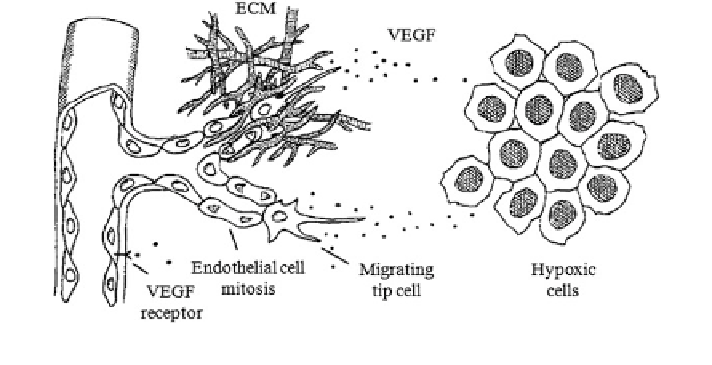Biomedical Engineering Reference
In-Depth Information
Fig. 1
Early events in sprouting angiogenesis (adapted from Bauer et al. [
7
])
vascular network is modified through network enlargement or pruning. In the
latter, new capillaries form from existing vessels and are directed toward a vas-
cular tissue. Here we focus on the latter. In the case of tissue engineering, wound
healing and thrombosis, newly formed capillaries grow in a controlled manner and
stop growing once the pathological condition has been alleviated; this is, however
not the case for tumor-induced angiogenesis [
39
].
2.1 Biology of Vascular Ingrowth
Angiogenesis is a complex regulated process, in which endothelial cell (EC)
growth, migration and tube formation are regulated by pro and anti-angiogenic
factors, matrix degrading proteases and cell extracellular matrix interactions. It
includes several basic steps [
38
] (see Fig.
1
):
• Activation of endothelial cells and vasodilatation of the parental vessel. Endo-
thelial cells are activated by angiogenic growth factors. This switches the
endothelial cells from the quiescent endothelial phenotype to an active mes-
enchymal phenotype, which secretes enzymes and growth factors and can
migrate and proliferate. The initial vasodilatation of parental vessels is
accompanied by the increase in permeability which is frequently driven by an
excess of vascular endothelial growth factor (VEGF), nitric oxide, or other
mediators.
• Local degradation of the basement membrane and surrounding extracellular
matrix of the vessel by proteases (matrix metalloproteinases and serine prote-
ases). The basement membrane coats the exterior of blood capillaries and is
believed to maintain endothelial stability, impermeability, and resistance against
the hydrostatic pressure of the blood flow within vessels [
105
]. Thus, the local

Search WWH ::

Custom Search